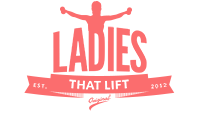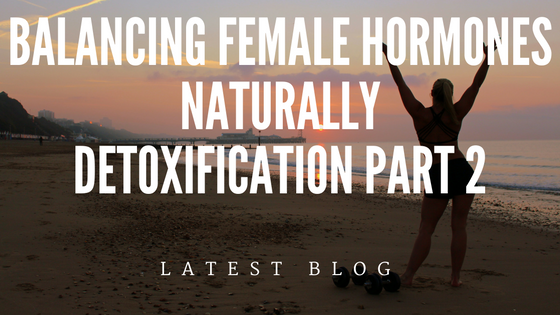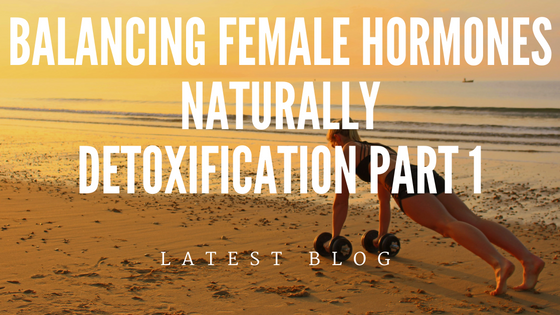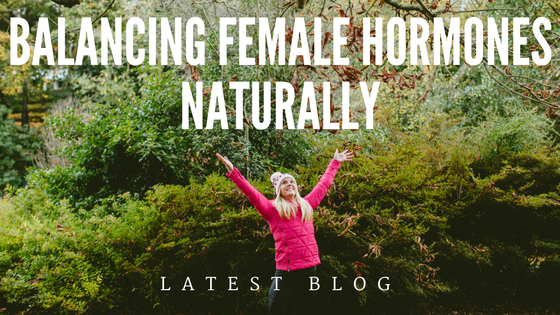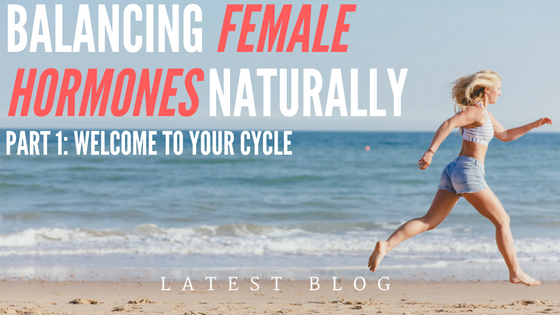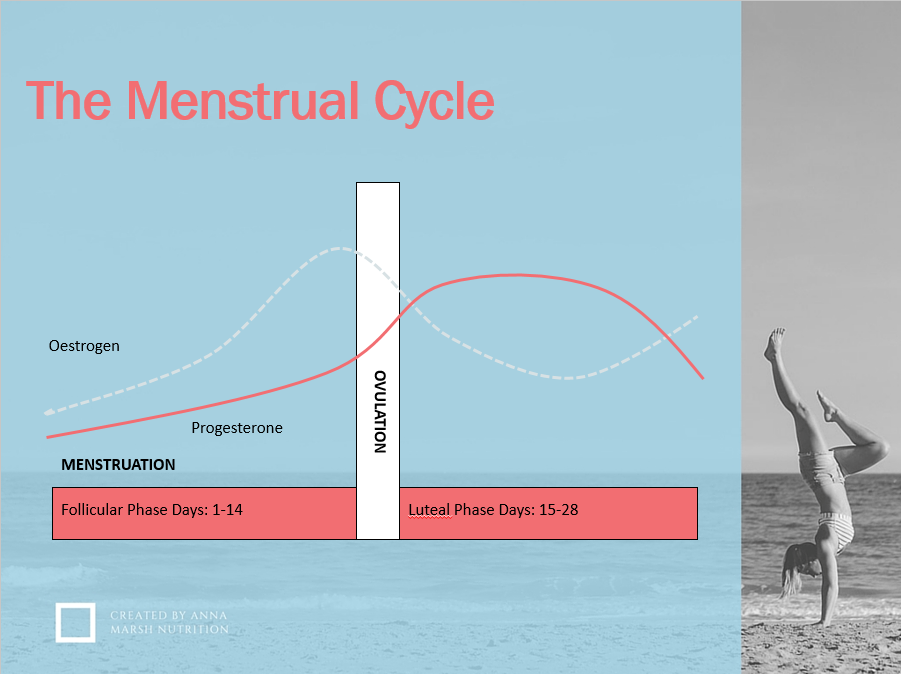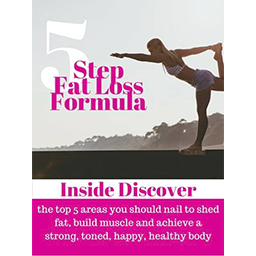Today I am sharing with you the second part on detoxification.
In part 1 we looked at why “traditional” detox diets are actually the complete opposite of what one should be doing to support detoxification and how some of these practises can hinder, and not help, female hormone balance.
So today is really about looking at what you can do and eat and how to do this with female hormone balance in mind.
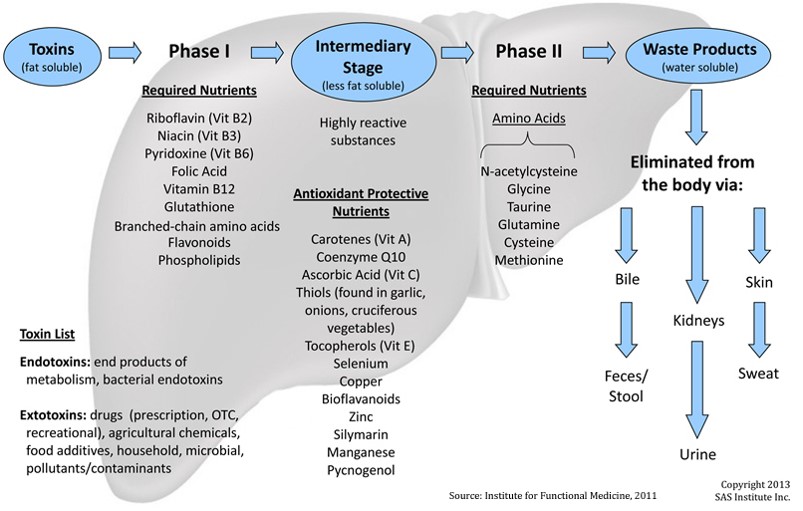
Above is a picture of the liver, the different phases of detoxification (phase 1 and 2) and the nutrients that can help or hinder it.
Carbohydrate
The liver is the place in the body where excess sugar is turned into fat. It is also the place where we process fructose, the natural fruit sugar.
If the liver is busy processing excess and fructose then it won’t be busy doing it’s detox job.
It is important to distinguish here that excess sugar does not solely refer to the white stuff you might add to tea and coffee, but any carbohydrates as a whole.
This would include excessive consumption of grains, cereals, breads, pasta, potatoes as well as fruits.
Lowering carbohydrate intake and focusing on carbohydrates from root vegetables like carrots, butternut squash, parsnips, beetroot AND avoiding grains, cereals and processed is the way to go.
If you suspect that you may have some “liver stuff” going on, I would even recommend a short term abstinence from fruit (4 weeks). However, you will see that some fruits have beneficial nutrients that will support detoxification in the longer term.
Fruit juices are a definite must to avoid which I am sure you can see contradicts “traditional” detox practises.
One of my favourite lines from one of my lectures was when someone asked “But what if you juice is yourself?” and the lecturer answered “Well then you just have homemade fructose!“
Proteins
Under phase 2 detoxification you will see certain amino acids listed.
Amino acids are protein building blocks and their significance as part of phase 2 needs explaining.
Detoxification is about transforming molecules for excretion. Molecules are initially transformed via phase 1 to even more toxic molecules (the intermediary stage). Toxic intermediary stage molecules are converted by using amino acids in phase 2 to water soluble molecules that can be excreted.
What happens if you don’t have enough of these amino acids?
The process gets “stuck” in the middle and you can have a build up of even more damaging molecules.
Therefore, we must get enough protein by dietary or supplemental means for healthy detoxification to take place.
- I would recommend somewhere between 1.5g-2.0g of protein per kilogram body weight as a general statement.
- Getting protein from organic sources is ideal although not essential provided you buy lean protein sources
- Certain proteins like fish, seafood and lamb can be easy on digestion.
- Slow cooking meats (perfect at this time of year) will be easier on digestion but you will also generate less harmful compounds than by grilling or frying
- Whey protein has been shown to raise an important anti-oxidant compound called glutathione which is essential for successful detoxification and could therefore we used to supplement protein intake
- Bone broths (stock made from slow cooked meat bones – another great one for the time of year) are high in glycine and great for the gut and detox pathways.
Fats
Fat’s do not have a direct role in detoxification per se, however, we already know that fats are essential for creating healthy hormones.
Additionally, dietary fat sources provide fat soluble vitamins like A, D & E all of which act as anti-oxidant buffers to prevent damage create by intermediary stage molecule.
We rely on healthy liver function to be able to digest and process fats properly. This creates a catch 22 where if liver function is poor, we cannot get the nutrients we need and if we can’t get the nutrients we need then liver function is affected.
If you want to support the body as best as possible I recommend focusing on:
- Anti-inflammatory fats such as omega 3 (oily fish) and monounsaturated fats such as olives, avocado and olive oil
- Walnut oil is high in vitamin E
- Oily fish will be high in vitamin D and omega 3
- Animal liver, is high in the most bio available form of vitamin A
- Apart from coconut oil, avoid saturated fats by opting for lean cuts of meat and poultry
- Definitely avoid processed seed oils sold in plastic or clear glass bottles.
- If you struggle to digest fats, perhaps consider speaking with someone about a digestive enzyme
Calories
Detoxification is an energetic process so adequate calorie consumption is essential. The goal is not to restrict but to eat an abundance of good quality food to maximise on vitamin and mineral consumption.
I say this every week but one of the biggest issues I see with women is chronic under-eating or over-eating but the wrong foods.
We need to meet in the middle and eat more of the good stuff and less bad stuff!
Eat the Rainbow
In addition meeting calorie and macro needs you will notice that certain plant based foods and B-vitamins are listed above.
The chemicals in every plant that give it it’s colour or maybe protect it against being consumed by insects or the sun, can have a positive impact on human health.
These plant chemicals are called phyto-chemicals or phyto-nutrients.
The best way to ensure you get enough is to eat a wide variety of colourful plant based foods.
I sometimes set my clients the challenge of eating 100 different plant based foods in a week!
Try it, it isn’t easy.
But consider how you can add more variety into your diet.
Walk around the supermarket and buy vegetables you wouldn’t normally buy.
Add 20 ingredients into a salad.
And don’t forget about herbs and spices too.
Out of all of these there are some specific food which have been proven to support detoxification:
- Cruciferous vegetables
- Pomegranate
- Green Tea
- Coffee
- Turmeric
- Ginger
- Onions
- Garlic
- Coriander
- Dill
- Rosemary
- Mint
- Citrus
- Beetroot
To name a few…
Bring it all together
So really what I have described here is a health diet:
- A diet with adequate calories – not too much or too little
- Healthy and balanced protein intake
- Moderate carbohydrates
- An abundance of healthy fats
- A wide variety of fresh colourful plant based foods
- And if you want something to drink water, herbal teas and the occasional coffee or glass of organic wine will be just fine
And I tell you now, if you can build these habits, not only will you feel better but you will probably lose weight and have better energy too.
I actually believe that detoxification is a life long journey.
It’s not a 30 day challenge or 7 day juice fast.
We live in a very toxic environment and if you were to worry about every little toxin your are exposed to, you would go bonkers!
But what you can do is make a daily and continuous effort to do the best to minimise exposure and put the good things in.

I run a small Online Women’s Weight Loss Program that offer a personalised nutrition and exercise support to produce life changing and life-lasting results.
If you want to give up the guessing game and have someone just tell you what to do and hold you accountable to actually doing it then this is probably exactly what you have been waiting for.
Life doesn’t get better by chance, it gets better by choice. Now you have a moment where you can choose to take a step towards a very different future and join the community of like minded women who are not just losing weight, but transforming their lives, filling them with happiness and health.
To find out more about how my coaching program can help you, please fill out the application below to book a complimentary breakthrough call and find out out about working with me in more detail.
